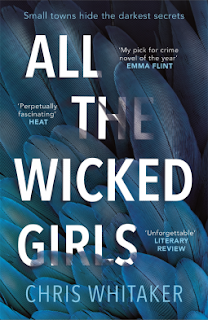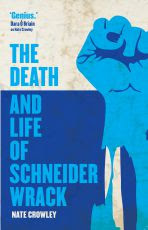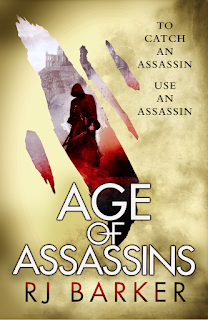 |
| Image from www.goodreads.com |
Adam Roberts
Gollancz, 24 August 2017
HB, 240pp
I'm grateful to the publisher for an advance copy of this book via NetGalley - it's always good to be approved for an advance copy, but particularly here as I always look forward to a new book from Adam Roberts.
And The Real Town Murders - which is both a science fiction and a crime story - didn't disappoint. It has that recognisably Robertsian tone - that is, serious in theme if slightly silly on the surface, packed with allusions so sly that you have to go back and check if you really read what you thought you did and glorying in puns and cheeky plays on words. So we have gems like "You're not the Mycroft. You're the Yourcroft"; phrases like "Man-hating transfer" or "gutter perches" shamelessly put into a character's mouth "for some reason" puns without the punning, pure puns with no object or reference.
All that, and the book is also recklessly, relentlessly inventive and beautifully written. Really, really well written: in places the language almost sparkles and glitters (especially when it's describing sparkling and glittering things). For example: "Sunlight sparkled grey off the dust coating every one of the building's hundreds of windows" or "A solitary bot moved very slowly over the weedy concrete". There is a whole series of descriptions of sky and water that caught my fancy, both original ("The sky was a lake of unlit petrol", "Sky the colour of an old man's hair", "Textured like hammered pewter. Grey like the steel from which Excalibur was forged", "...the Thames, all of its surface teeming eels of pure light and pure brightness in the afternoon sun") and nods elsewhere ("light fizzing off ten thousand wave peaks like a screen tuned to a dead channel").
The half quote from Neuromancer is particularly apposite because this book's background assumes a world where virtual reality is overtaking the real Real. The Shine is the place where all the fun is to be had, which is why Reading (or R!-Town as it's been renamed, in a lame marketing effort) is so empty (twelve people or so constitutes a crowd). Those who can, choose to spend their time indoors, dormant, plugged into the Shine: those who have no choice - prisoners, patients in hospital - are made to: it's easier to handle them that way.
Horrible, perhaps, but not a dystopia, not exactly. There hasn't been an apocalyptic event, the world is still complete, it's just that several decades of consequences and technological evolution have taken us in a troubling direction. The outcome is that familiar streets - I've walked along some of the road Roberts describes - have become strange and eerie, beautiful at times in their emptiness, observed only by the few who can't or won't go where the fun is.
The main character is one of these misfits. Alma is a private detective who at the start of the book has been retained to investigate a classic locked-room mystery - a murdered corpse in the boot of a new car, assembled before our eyes (or rather, before omnipresent CCTV) in a factory. A factory, which, incidentally, makes high end, "artisanally produced" cars - that is, they are lovingly assembled in the traditional manner by robots rather than merely being printed. That gives them a certain cachet in this world of the virtual Shine, of AIs, of empty streets and canteens - and a key role in the ideological struggle between the real and the virtual realms.
Alma has no religious objection or medical reason for resisting the Shine, a fact she finds hard to explain to her prospective clients. Rather, she is bound to stay in the Real in order to tend to her beloved, her pearl Marguerite. Marguerite has been infected by a modded virus, which cases a crisis every four hours and four minutes. The malady is keyed to Alma's DNA so that only she can diagnose and treat it.
Ridiculous as this premise may sound put so baldly, Roberts makes it work. In his it becomes a touching vulnerability for Alma, the successive needs to get out of whatever scrape she's in and return home really piling on the tension. It also adds an intriguing question which is never answered - how did this happen to Marguerite, and why? I very quickly lost any doubt about this setup, so well is Alma's need conveyed. And Marguerite is a wonderful character, the Mycroft to Alma's Holmes, as hinted in the quote above. She's a full part of this investigation and spots not only the immediate solution to the crime, but the wider dangers, long before Alma catches on.
And there are dangers. In essence this book is one long chase. Alma is engaged for a case, warned off, threatened, contacted by a mysterious inside source, arrested, escapes, is pursued, shot at, and so on - for all the world like the hero of a Hitchcock film (and, in one mysterious scene, there is even an appearance by a mysterious fat man...) Even without the need to care for Marguerite, her chances of survival look small. But she's resourceful and won't give up so we have the setup for a classic action thriller. Yet if it's Adam Roberts does Alfred Hitchcock it could as easily be Adam Roberts does Julius Caesar (I think - given the politics, and some of the speeches) or several other genres (did the scenes with the argumentative lift AI echo Hitchhiker's Guide to the Galaxy? Of course they did.)
In other words, it's clever, well thought out, many layered, allusive and tricksy, something else I've come to expect from Roberts' books. With some authors that might seem a little show-offy, a bit look-at-me, but I never get that feeling from Roberts' books. If you get these references they add to the enjoyment, but understanding the book doesn't depend on getting them, and there's lots of fun to be had here anyway.
The book ends with many open questions for both Alma and the reader, and I'm really hoping that Roberts will return to R!-town again, with some answers (and more questions).




